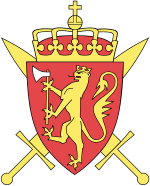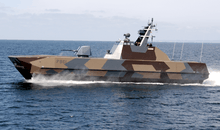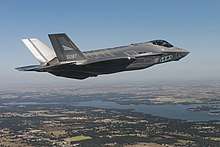Norwegian Armed Forces
The Norwegian Armed Forces (Norwegian: Forsvaret, "The Defence") is the military organisation responsible for the defence of Norway. It consists of four branches, the Norwegian Army, the Royal Norwegian Navy, which includes the Coast Guard, the Royal Norwegian Air Force, and the Home Guard, as well as several joint departments.
| Norwegian Armed Forces | |
|---|---|
| Forsvaret | |
 Coat of arms | |
| Founded | 1628 |
| Current form | 1990 |
| Service branches | |
| Headquarters | Norwegian Joint Headquarters |
| Website | Official website |
| Leadership | |
| King | Harald V |
| Prime Minister | Erna Solberg |
| Minister of Defence | Frank Bakke Jensen |
| Chief of Defence | Admiral Haakon Bruun-Hanssen |
| Manpower | |
| Military age | Male: 17-44 (55 for officers) years of age for compulsory military service.
Female: 17 years of age for military service. Compulsory for females born in 2000 or later. |
| Conscription | 19-month service obligation. |
| Reaching military age annually | 31,980 males, 30,543 females |
| Active personnel | 23,250 (2018)[1] |
| Reserve personnel | 40,000 in the Norwegian Home Guard (2018)[1] |
| Deployed personnel | 266 (2018)[2] |
| Expenditures | |
| Budget | US$7.179 billion (2019)[3] US$1,320 per capita (2018)[4] |
| Percent of GDP | 1.70% (2019)[3] |
| Related articles | |
| History | Military history of Norway |
| Ranks | Ranks and insignia |
The military force in peace time is around 23,250 personnel including military and civilian staff, and around 63,250 in total with the current military personnel, conscripts and the Norwegian Home Guard in full mobilization.[1]
An organised military was first assembled in Norway in the 9th century and was early focused around naval warfare. The army was created in 1628 as part of Denmark–Norway, followed by two centuries of regular wars. A Norwegian military was established in 1814, but the military did not see combat until the German occupation of Norway in 1940. Norway abandoned its position as a neutral country in 1949 to become a founding member of the North Atlantic Treaty Organisation (NATO). The Cold War saw a large build-up of air stations and military bases, especially in Northern Norway. Since the 2000s, the military has transformed from a focus on defence from an invasion to a mobile force for international missions. Among European NATO members, the military expenditure of US$7.2 billion is the highest per capita.
Organisation
The formal commander-in-chief is King Harald V; however, the de facto supreme decision-making is made by the Cabinet, led by the Prime Minister. The Chief of Defence (a four-star general or admiral) is the professional head and leader of the armed forces, and is the principal military adviser to the Minister of Defence. The Chief of Defence and his staff is located at Akershus Fortress in Oslo, while the Norwegian Joint Headquarters, responsible for commanding operations, is located in Bodø. The main naval base is Haakonsvern in Bergen, the main army camps are in Bardu, Målselv and Rena, and the main air station is Ørland.
Military branches (in order of seniority):
- Norwegian Army
- Royal Norwegian Navy
- Royal Norwegian Air Force
- Home Guard
- Norwegian Cyber Force
- Norwegian Special Operation Forces (NORSOF)[5]
Other main structures include:
- Defence Staff Norway (DEFSTNOR) in Oslo acts as the staff of the Chief of Defence. It is headed by a three-star general or admiral. DEFSTNOR assigns priorities, manages resources, provides force generation and support activities. Each of the four branches of defence is headed by a two-star general/admiral who are subordinate to DEFSTNOR.
- Norwegian Joint Headquarters (NJHQ) located at Reitan, close to Bodø has operational control of Norwegian armed forces worldwide 24/7. It is headed by the Supreme Commander Norwegian Forces – a three-star general or admiral.
- Norwegian Defence Logistics Organisation (NDLO) at Kolsås outside Oslo is responsible for engineering, procurement, investment, supply, information and communications technology. It is also responsible for maintenance, repair and storage of material.
Conscription

Norway employs a weak form of mandatory military service for men and women. While 63,841 men and women were called in for the examination of persons liable for military service in 2012 (mandatory for men), 9265 were conscripted.[6][7] In practice recruits are not forced to serve, instead only those who are motivated are selected.[8] In earlier times, up until at least the early 2000s, all men aged 19–44 were subject to mandatory service, with good reasons required to avoid becoming drafted.
Since 1985, women have been able to enlist for voluntary service as regular recruits.[9] On 14 June 2013, the Norwegian Parliament voted to extend conscription to women.[10] In 2015 conscription was extended to women making Norway the first NATO member and first European country to make national service compulsory for both men and women.[11] There is a right of conscientious objection.
Structure
Joint
- 1 Norwegian Joint Headquarters in Bodø
- Norwegian Intelligence Service
- 12 Home Guard districts
- Tactical Mobile Land/Maritime Command
- Joint ISTAR Unit (Intelligence, Surveillance, Target Acquisition and Reconnaissance)
- Module based ISTAR Unit
- Norwegian Coastal Ranger Command (Kystjegerkommandoen in Norwegian)
- Unmanned aerial vehicle capability
- Airborne Ground Surveillance (joint NATO project)
- Norwegian Home Guard – 45,000 personnel, rapid reaction forces, follow-on-forces, reinforcement forces and reserves.
- Capacity for information operations
- Norwegian Defence Security Department (NORDSD)
- Flexible medical units
- NRBC protection (Nuclear, radiological, biological, chemical weapons )
- Explosive Ordnance Disposal
- Joint C2I Unit (command, control and information)
- Civil Military Coordination Unit (CIMIC)
- Deployable logistical support
- 2 mobilisation host country battalions (logistics for allied reinforcements)
.jpg)
Norwegian Army
From 1 August 2009 the Norwegian Army changed its structure:[12][13]
- Brigade Nord (operational units)
- Army Weapons School
- HM the Kings Guard
- Garnisonen i Sør-Varanger
- Military Academy
- Logistics and Operational Support
- Operation Support Detachment
Royal Norwegian Navy

- 5 - 1 = 4 Fridtjof Nansen class Aegis frigates
- 6 Skjold class fast missile boats.
- 6 Ula class submarines
- Mine Warfare Capability
- 6 (8) Oksøy-class mine hunter and Alta-class minesweeper
- Mine Clearance Command (divers); HNoMS Tyr support vessel
- Naval Special Warfare Group
- Norwegian Coastal Ranger Command
- Mine Clearance Command (divers)
- Tactical Boat Squadron (CB90-Class fast assault craft)
- Logistics/Support Capacity
- Coast Guard
- 1 Svalbard class vessel
- 3 Barentshav class vessels
- 3 Nordkapp-class OPV
- Leased vessels (KV Tromsø and KV Ålesund, KV Harstad, 6 ocean patrol vessels)
- Inner coast guard (25 leased vessels)
- Tug capacity
- Strategic Sealift
Royal Norwegian Air Force

- 72 + 2(1987) F-16 Fighting Falcon about 50-60 operational. (Being replaced by 52 Lockheed Martin F-35 Lightning II)
- 2 Air Control Centre/Recognized Air picture Production Centre/Sensor Fusion post (ARS Sørreisa and ARS Mågerø)
- Strategic Airlift / Aerial refueling (common NATO projects)
- Maritime surveillance (4 x P-3C Orion and 2 x P-3N Orion). (Being replaced by five P-8A Poseidon, to be delivered between 2022 and 2023.[14])
- Electronic Warfare (2 + 1 DA-20 Jet Falcon)
- Transport 4x C-130J Super Hercules
- Air Defence Artillery (NASAMS 2)
- Air Wing for Special Forces (6 x Bell 412)
- 18 Bell 412 transport and light attack helicopters
- 6 NH-90 maritime helicopters (frigates)
- Deployable base support
- 12 Sea King search and rescue helicopters. (Being replaced by 16 AW101[15][16])
Norwegian Home Guard
- Home Guard (Air, Sea and Land)
Norwegian Cyber Defence Force
- Norwegian Cyber Defence Force
Norwegian Special Operation Forces
- Armed Forces' Special Command (Norwegian: Forsvarets Spesialkommando) (FSK)[5]
- Jegertroppen (English: Jeger Troop)
- Navy Special Operation Command (Norwegian: Marinejegerkommandoen) (MJK)[5]
Small arms and handguns
- Heckler & Koch MP5 – replaced by the MP7 in some positions
- Heckler & Koch MP7 - standard issue SMG
- Heckler & Koch HK416 – standard assault rifle
- M320 grenade launcher – used as a grenade launcher on the HK 416 and as a standalone weapon
- Heckler & Koch HK417
- Heckler & Koch G36 – special forces only,
- Colt Canada C7 rifle – special forces only
- Colt Canada C8 rifle – special forces only
- AG3 – former standard assault rifle; currently used by parts of the Home Guard. No longer in service
- Barrett M82
- Barrett MRAD
- Glock 17 – standard issue pistol, replaced by the MP7 in some positions
- Heckler & Koch USP – in use with special forces
- Rheinmetall MG3 – will be replaced by FN Minimi and FN MAG as crew weapon
- FN Minimi
- M2 Browning – known as 12,7 MITR
- M72 LAW – light anti-armour weapon
- Carl Gustav recoilless rifle – anti-armour weapon
- FGM-148 Javelin – anti-armour guided missile[17]
- M320 Grenade Launcher Module[18]
Citations
- IISS 2019, p. 133.
- IISS 2019, p. 135.
- "Defence Expenditure of NATO Countries (2012-2019)" (PDF). NATO Public Diplomacy Division. 25 June 2019. Retrieved 8 July 2019.
- "SIPRI Military Expenditure Database". Stockholm International Peace Research Institute. Retrieved 28 July 2020.
- Olsen, Tommy; Thormodsen, Marius (June 2014). Forging Norwegian Special Operation Forces (Master's thesis). U.S. Navy Postgraduate School. OCLC 893922200. Retrieved 16 September 2017.
- "NDF official numbers". NDF. Archived from the original on 2011-01-12. Retrieved 2007-07-16.
- "NDF official numbers". NDF. Retrieved 2007-07-16.
- "Norway's military conscription becomes gender neutral". Deutsche Welle. Retrieved 2015-11-24.
- https://www.nato.int/ims/2001/win/norway.htm
- "Norway becomes first NATO country to draft women into military". Reuters. Retrieved 2013-06-15.
- "Universal Conscription". Norwegian Armed Forces. 11 June 2015. Archived from the original on 5 March 2016. Retrieved 25 June 2016.
- "Front page – Mil.no" (PDF). Retrieved 24 December 2014.
- "Front page – Mil.no" (PDF). Retrieved 24 December 2014.
- "Norge har inngått kontrakt om kjøp av fem nye P-8A Poseidon maritime patruljefly". Regjeringen.no. 29 March 2017.
- Perry, Dominic (20 November 2017). "Norway takes first SAR-roled AW101". Flight Global. Archived from the original on 20 November 2017. Retrieved 20 November 2017.
- Jennings, Gareth (19 November 2017). "Norway receives first AW101 SAR helicopter". IHS Jane's 360. Archived from the original on 20 November 2017. Retrieved 20 November 2017.
- "Perfecting the Javelin simulator – the new anti-armor weapon is being phased in this year". Hærens Styrker. 17 March 2009. Archived from the original on 22 May 2009. Retrieved 17 June 2009.
- Forsvaret. "AG-HK416 granatutskytningsrør".
References
- IISS (2019). The Military Balance 2019. Routledge. ISBN 978-1857439885.
External links
| Wikimedia Commons has media related to Norwegian Armed Forces. |
- Royal Norwegian Ministry of Defence
- Norwegian Defence Force
- One for all, all for one? New Nordic Defence Partnership? Publication from the Nordic Council of Ministers. Free download.
- Norwegian and Danish defence policy: A comparative study of the post-Cold War era A historical and comparative study published by the Norwegian Institute for Defence Studies. Free download.

